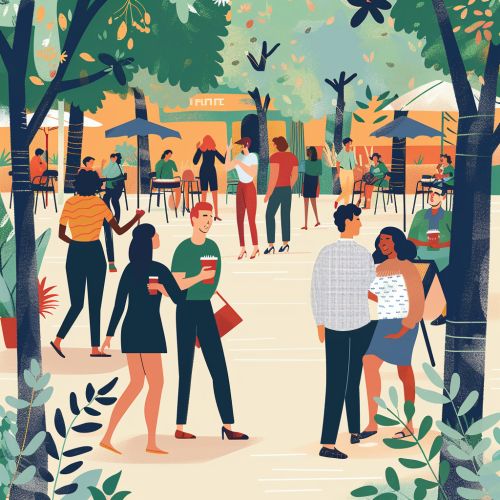Social Norm
Introduction
A social norm is a rule or guideline in a society or group that dictates acceptable behavior, beliefs, and attitudes. These norms are often unwritten and evolve over time, shaping and being shaped by the collective behaviors and expectations of the group. Social norms can vary widely between different cultures, subcultures, and social contexts, and they play a crucial role in maintaining social order and cohesion.
Types of Social Norms
Social norms can be categorized into various types based on their nature and the context in which they operate. The primary types include:
Folkways
Folkways are the everyday norms that govern casual interactions. They are the customary ways of doing things that are not strictly enforced but are followed by members of a society. Examples include dress codes, table manners, and greetings. Violating folkways typically results in mild social disapproval rather than severe punishment.
Mores
Mores are norms that are seen as vital to the moral fabric of society. They embody the moral views and principles of a group. Violations of mores are considered serious and can result in significant social condemnation or legal penalties. Examples include norms against theft, murder, and adultery.
Laws
Laws are formalized norms that are codified and enforced by governmental institutions. They are designed to regulate behavior within a society and ensure social order. Laws are backed by formal sanctions, including fines, imprisonment, and other legal penalties.
Taboos
Taboos are the most deeply ingrained norms, prohibiting actions that are considered extremely offensive or unacceptable. Violating a taboo can lead to severe social ostracism and even legal action. Examples of taboos include incest and cannibalism.
Formation and Enforcement of Social Norms
Social norms are formed through a complex interplay of individual behaviors, social interactions, and cultural influences. They are reinforced through various mechanisms, including:
Socialization
Socialization is the process through which individuals learn and internalize the norms, values, and behaviors appropriate to their society. This process begins in childhood and continues throughout life, involving family, peers, educational institutions, and media.
Sanctions
Sanctions are the reactions of others to the behavior of an individual. They can be positive (rewards) or negative (punishments) and serve to reinforce conformity to social norms. Positive sanctions include praise, approval, and social acceptance, while negative sanctions include criticism, disapproval, and social exclusion.
Role Models
Role models are individuals who exemplify the norms and values of a society. They influence others by demonstrating acceptable behavior and attitudes. Role models can be parents, teachers, celebrities, or any respected member of the community.
Social Institutions
Social institutions such as family, education, religion, and government play a crucial role in the formation and enforcement of social norms. These institutions provide the structure and context within which norms are learned and upheld.
Theoretical Perspectives on Social Norms
Several theoretical frameworks have been developed to understand the nature and function of social norms. Some of the most prominent include:
Functionalism
Functionalist theories view social norms as essential components of social order. According to this perspective, norms contribute to the stability and cohesion of society by regulating behavior and ensuring predictability in social interactions.
Conflict Theory
Conflict theories argue that social norms are a reflection of the power dynamics within a society. Norms are seen as tools used by dominant groups to maintain their control and suppress subordinate groups. This perspective highlights the role of inequality and power struggles in the formation and enforcement of norms.
Symbolic Interactionism
Symbolic interactionism focuses on the micro-level interactions through which social norms are created and maintained. This perspective emphasizes the importance of symbols, language, and communication in the construction of social reality. Norms are seen as emerging from the ongoing interactions and negotiations between individuals.
Social Norms and Social Change
Social norms are not static; they evolve over time in response to changes in society. Factors that can lead to changes in social norms include:
Technological Advancements
Technological innovations can alter the way people interact and communicate, leading to new norms and behaviors. For example, the rise of social media has transformed norms around privacy, communication, and social relationships.
Cultural Exchange
Exposure to different cultures through travel, migration, and media can lead to the adoption of new norms and the modification of existing ones. Cultural exchange promotes diversity and can challenge traditional norms.
Social Movements
Social movements advocate for changes in social norms and values. Movements such as civil rights, feminism, and LGBTQ+ rights have successfully challenged and transformed societal norms related to race, gender, and sexuality.
Economic Changes
Economic shifts, such as industrialization, globalization, and changes in the labor market, can influence social norms. For example, the increasing participation of women in the workforce has led to changes in gender roles and family dynamics.
Social Norms in Different Cultures
Social norms vary significantly across cultures, reflecting the diverse values, beliefs, and practices of different societies. Some examples include:
Individualism vs. Collectivism
In individualistic cultures, such as the United States and Western Europe, norms emphasize personal autonomy, self-expression, and individual rights. In contrast, collectivist cultures, such as Japan and China, prioritize group harmony, social cohesion, and collective well-being.
High-Context vs. Low-Context Communication
High-context cultures, such as those in East Asia and the Middle East, rely heavily on implicit communication and non-verbal cues. Norms in these cultures emphasize indirect communication and the importance of context. Low-context cultures, such as those in North America and Western Europe, value explicit communication and directness.
Power Distance
Power distance refers to the extent to which a society accepts and expects power inequalities. In high power distance cultures, such as India and Mexico, norms support hierarchical relationships and respect for authority. In low power distance cultures, such as Sweden and Australia, norms favor egalitarianism and equal distribution of power.
Deviance and Social Control
Deviance refers to behaviors or actions that violate social norms. The concept of deviance is relative, as what is considered deviant in one culture or context may be acceptable in another. Social control mechanisms are employed to manage deviance and maintain social order. These mechanisms include:
Informal Social Control
Informal social control involves the reactions of individuals and groups to deviant behavior. This can include gossip, ridicule, ostracism, and other forms of social pressure. Informal social control is often more effective in small, close-knit communities where social ties are strong.
Formal Social Control
Formal social control is exercised by authorized institutions such as the police, courts, and regulatory agencies. It involves the use of laws, regulations, and official sanctions to deter and punish deviant behavior.
Theories of Deviance
Several theories have been developed to explain deviance, including:
Strain Theory
Strain theory, proposed by Robert K. Merton, suggests that deviance occurs when there is a disconnect between societal goals and the means available to achieve them. Individuals may resort to deviant behavior when they experience strain or pressure to achieve success.
Labeling Theory
Labeling theory, developed by Howard Becker, posits that deviance is a result of societal labels. When individuals are labeled as deviant, they may internalize this label and continue to engage in deviant behavior.
Social Learning Theory
Social learning theory, associated with Albert Bandura, argues that deviance is learned through interactions with others. Individuals may adopt deviant behaviors by observing and imitating others, especially if these behaviors are reinforced.
Social Norms and Public Policy
Social norms play a significant role in shaping public policy and governance. Policymakers often consider existing norms and values when designing and implementing policies. Conversely, public policies can influence social norms by promoting or discouraging certain behaviors. Examples include:
Public Health Campaigns
Public health campaigns aim to change social norms related to health behaviors, such as smoking, alcohol consumption, and vaccination. These campaigns use education, media, and incentives to promote healthier behaviors.
Environmental Policies
Environmental policies seek to alter norms related to resource consumption, waste management, and sustainability. Policies such as recycling programs, carbon taxes, and conservation initiatives encourage environmentally responsible behavior.
Social Welfare Programs
Social welfare programs address norms related to poverty, inequality, and social justice. Programs such as unemployment benefits, healthcare, and education aim to support vulnerable populations and promote social equity.
Conclusion
Social norms are fundamental to the functioning of societies, guiding behavior and maintaining social order. They are dynamic and context-dependent, influenced by cultural, economic, and technological factors. Understanding social norms is essential for comprehending human behavior, social interactions, and the mechanisms of social control. As societies continue to evolve, so too will the norms that govern them, reflecting the changing values and priorities of their members.


